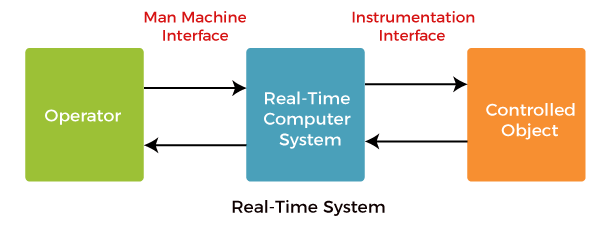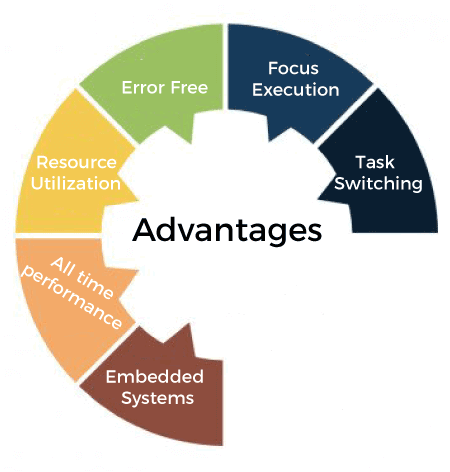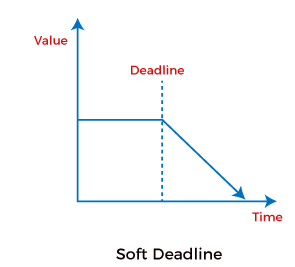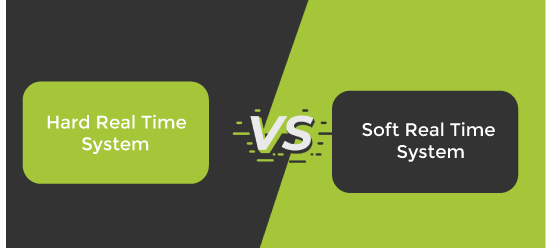Hard and Soft Real-Time Operating System
A real-time operating system (RTOS) is intended to serve real-time applications that process data without buffer delays. A real-time system is a time-bound system with well-defined and fixed time constraints, and processing must be done within the defined constraints; otherwise, the system will fail. In a real-time operating system, processing time requirements are measured in tenths of seconds.

Real-Time System is used at those Places where we require higher and timely responses. Real-time operating systems involve a set of applications where the operations are performed on time to run the activities in an external system. It uses the quantitative expression of time to analyze the system’s performance.
The deadline in the context of a real-time system is the moment of the time by which the job’s execution is needed to be accomplished. Most real-time operating systems use a pre-emptive scheduling algorithm.
Examples of Real-Time Operating Systems
Below are some examples of the real-time operating system, such as:
- The operating system of the microwave oven.
- The operating system of the Washing machine.
- The operating system of the aeroplane.
- The operating system of digital cameras and many more.
The quick response of the process is a must in real-time operating systems. There is no chance of any delay in completing any process because a little delay can cause several dangerous issues.
Advantages of Real-Time Operating Systems
The real-time operating system has the following advantages, such as:

- Task switching: Real-time operating systems are designed, so that starting switching is a very quick process. A normal traditional operating system takes a lot of time while switching from one person to another process. The real-time operating system completes the task switching only within some of the microseconds.
- Focus execution: The main focus of real-time operating systems is to handle the task in execution, and just a little focus is on the task in waiting.
- Error-free: Real-time operating systems are designed very carefully, and different kinds of software testing techniques are applied to the real-time operating system to test the system. This detailed testing makes the real-time operating system approximately error-free.
- Maximum resource utilization: Real-time operating systems are designed to follow the task within a given time secretly. This is not simple and easy to complete the task within time. The real-time operating system utilizes all the hardware efficiently and completely. The main focus of the real-time operating system is not to save energy or resources. So we can see that the real-time operating system utilize the resources completely and very efficiently.
- Usage in embedded systems: Real-time operating systems can also work with embedded systems.
- All-time performance: Real-time operating systems are designed to works 24 hours a day and every day.
Types of Real-Time System
A real-time operating system is divided into two systems, such as:
- Hard real-time system
- Soft real-time system
Hard and Soft real-time systems are the variants of real-time systems where the hard real-time system is more restrictive than the soft real-time system. The hard real-time system must assure to finish the real-time task within the specified deadline. While this is not the case in the soft real-time system, it assigns superior scheduling priority to real-time tasks.
Hard Real-Time System
A hard real-time system considers timelines as a deadline, and it should not be omitted in any circumstances. Hard real-time Systems do not use any permanent memory, so their processes must be complete properly in the first time itself.

Hard Real-Time System must generate accurate responses to the events within the specified time. A hard real-time system is a purely deterministic and time constraint system.
For example, users expected the output for the given input in 5 sec then the system should process the input data and give the output exactly by the 5th second. It should not give the output by the 6th second or by the 4th second. Here above 5 seconds is the deadline to complete the process for given data. In the hard real-time system, meeting the deadline is very important if the deadline is not met, the system performance will fail.
Examples of Hard Real-Time Systems
Below are some examples of the hard real-time operating system, such as:
- Flight Control Systems
- Missile Guidance Systems
- Weapons Defense System
- Medical System
- Inkjet printer system
- Railway signalling system
- Air traffic control systems
- Nuclear reactor control systems
- Anti-missile system
- Chemical plant control
- Autopilot System in Plane
- Pacemakers
Soft Real-Time System
A soft real-time system is a system whose operation is degraded if results are not produced according to the specified timing requirement. In a soft real-time system, the meeting of deadline is not compulsory for every task, but the process should get processed and give the result. Even the soft real-time systems cannot miss the deadline for every task or process according to the priority it should meet the deadline or miss the deadline.

If a system is missing the deadline every time, the system’s performance will be worse and cannot be used by the users. The best example for the soft real-time system is a personal computer, audio and video systems, etc.
Soft real-time systems consider the processes as the main task and control the entire task.
Examples of Soft Real-Time Systems
Here are some common examples of soft real-time operating systems, such as:
- Personal computer
- Audio and video systems
- Set-top boxes
- DVD Players
- Weather Monitoring Systems
- Electronic games
- Multimedia system
- Web browsing
- Online transaction systems
- Telephone switches
- Virtual reality
- Mobile communication
Difference between Hard and Soft Real-Time System
An operating system is system software that manages the computer hardware according to the instructions provided by the software. An operating system provides various tasks. File management, memory management, controlling peripheral devices and process scheduling are some of them. One type of operating system is a real-time operating system, and it is further divided into hard real-time systems and soft real-time systems.

The key difference between hard and soft real-time systems is that a hard-real time system is a system in which a single failure to meet the deadline may lead to a complete system failure. In contrast, a soft real-time system is a system in which one or more failures to meet the deadline are not considered complete system failure, but its performance is considered degraded.
| Terms | Hard Real-Time System | Soft Real-Time System |
|---|---|---|
| Definition | A hard-real time system is a system in which a failure to meet even a single deadline may lead to complete or appalling system failure. | A soft real-time system is a system in which one or more failures to meet the deadline are not considered complete system failure, but that performance is considered to be degraded. |
| File size | In a hard real-time system, the size of a data file is small or medium. | In a soft real-time system, the size of the data file is large. |
| Response time | In this system, response time is predefined that is in a millisecond. | In this system, response time is higher. |
| Utility | A hard-real time system has more utility. | A soft real-time system has less utility. |
| Database | A hard real-time system has short databases. | A soft real-time system has enlarged databases. |
| Performance | Peak load performance should be predictable. | In a soft real-time system, peak load can be tolerated. |
| Safety | In this system, safety is critical. | In this system, safety is not critical. |
| Integrity | Hard real-time systems have short term data integrity. | Soft real-time systems have long term data integrity. |
| Restrictive nature | A hard real-time system is very restrictive. | A Soft real-time system is less restrictive. |
| Computation | In case of an error in a hard real-time system, the computation is rolled back. | In a soft real-time system, computation is rolled back to a previously established checkpoint to initiate a recovery action. |
| Flexibility and laxity | Hard real-time systems are not flexible, and they have less laxity and generally provide full deadline compliance. | Soft real-time systems are more flexible. They have greater laxity and can tolerate certain amounts of deadline misses. |
| Validation | All users of hard real-time systems get validation when needed. | All users of soft real-time systems do not get validation. |
| Examples | Satellite launch, Railway signalling systems, and Safety-critical systems are good examples of a hard real-time system. | DVD player, telephone switches, electronic games, Linux, and many other OS provide a soft real-time system. |
